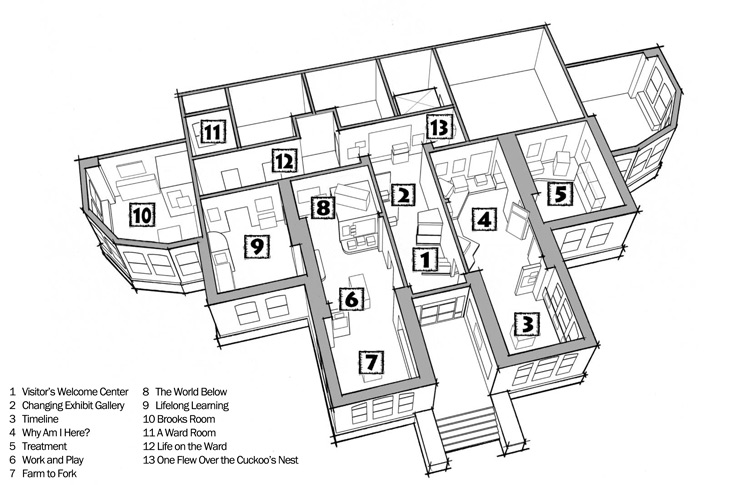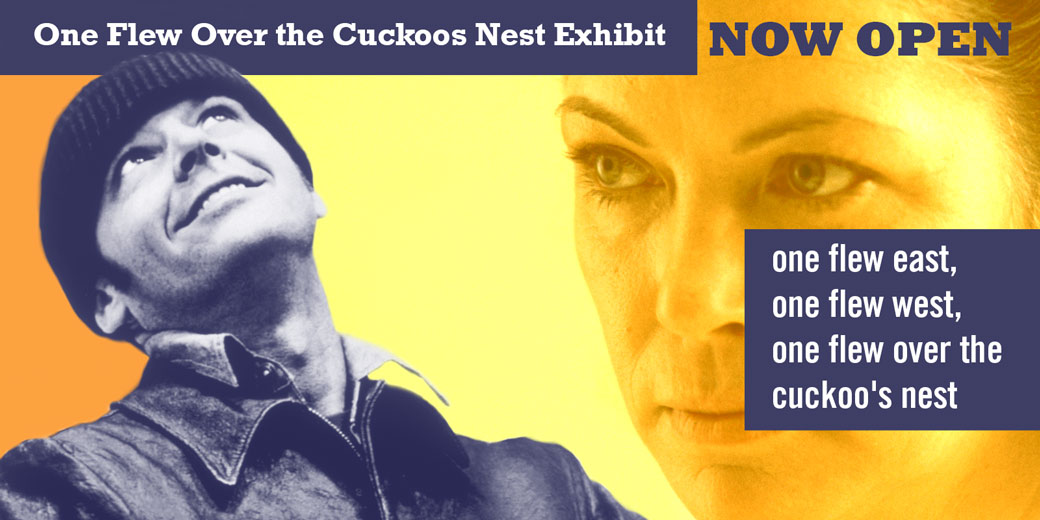Museum Exhibits

When you enter the museum you will be presented with the identification badge of an historic patient, staff member or visitor from the Hospital’s varied history. You can look for that person’s information somewhere in the museum. The color code of your badge will correspond to stories and artifacts throughout the museum. Next time you come, you’ll get the badge of a different person so each visit will let you look at mental health’s history through different eyes. The Visitor Welcome Center also exhibits donor appreciation materials, a small sales gallery, and Museum information services.
Because of the scope of the Museum’s mission and the extensive collection holdings, the exhibits throughout the museum are designed in modules that will be refreshed with new artifacts and information to keep the material interesting for repeat visitors while holding redesign and installation costs to a minimum. One gallery, however, is designed to hold changing and/or traveling exhibits that will be hosted at the museum for only limited runs. See what is currently showing here.
The large wrap-around timeline will guide you through the Hospital’s turbulent history with landmarks of state and national events to help ground your multidimensional discovery. Where did it all begin? When was electricity added? What effect did the national tuberculosis epidemic have on the Hospital? How did the Great Depression affect admissions? What laws and citizen initiatives have impacted life behind these walls? In addition to the timeline itself, secure pedestals displaying period artifacts make the history “real” with reminders of technologies of yesteryear.
Since the Hospital’s opening in 1883, what we think of as mental illness and what caused people to be committed to the State Hospital have changed dramatically. Many of those originally transported to what was then called the State Insane Asylum were classed as feeble-minded and suffered from ailments as diverse as syphilis and senile dementia. This large artifact-filled room traces the changes in the Hospital’s population as the understanding of various conditions and treatments changed what we think we know about mental illness. Pick up one of the vintage telephones to hear first person accounts of admissions to the hospital.
Since the Hospital opened it doors, efforts have been made to keep up with the most current thinking about treating mental illness. The very campus of the institution was once deemed integral to recovery by surrounding patients with natural light, handsome vistas and serene gardens. But there were also straight jackets, shackles, electric shock therapies, lobotomies, ice baths, drugs and sterilizations. The Treatment Room examines protocols once heralded as well as those now disgraced. Visitors learn how available therapies have actually dictated who was and was not able to be served at the State Hospital.
At a State institution, the taxpayers’ bottom line has always been a consideration. While at one time the hospital was virtually self-supporting, the notion of employing patients in useful tasks has undergone a sea change due to legal restrictions. Learn why psychiatric authorities have believed that both work and recreation play integral parts in treatment and what has curtailed many of those efforts. See what made the Oregon State Hospital nationally recognized as a leader in mental health therapies and what happened to those efforts.
The Hospital once owned two large farms and also cultivated much of the current campus holdings with patient labor. As a result, these farms met not only most of the nutritional needs of the patients and staff but also fed other state institutions such as universities and prisons. Find out what happened to these once fruitful agricultural enterprises. Check out kitchen equipment once used to feed more than 3000 people three meals a day and how, despite the enormous quantities that were prepared, individual accommodations were made to meet the needs of specific individuals.
The Oregon State Hospital buildings are connected by an extensive series of underground tunnels that have been used for everything from transportation of food and laundry to actually housing patients during periods of extreme overcrowding. At one time home to an indoor swimming pool, the weaving room, wood shop and beauty parlor, the tunnels have played important roles in the life of the Hospital, its residents and staff.
Children as young as six years old have been committed to the Hospital and, at one time, most doctors and nurses families lived on campus and their children played with and assisted patients. Almost every doctor trained in Oregon did a psychiatric rotation through the Hospital and for decades it ran its own nursing school. The Oregon State Hospital was also a training facility for chaplains seeking to minister to the mentally ill. This exhibit space will host artifacts and information about the Hospital’s libraries, religious services and training facilities with a special look at the lives of children on campus.
The Hospital’s stories are complex, often difficult and extremely emotional. Our history includes incidents of suicide and murder, violent attack and accidental mass poisoning as well as the demise of thousands of geriatric patients who were simply left behind. This room provides a quiet space where material will be held supporting the discovery of former patients whose cremains are held in more than 3000 canisters in a separate building. A documentary helping visitors understand the life-cycles that have taken place at the institution is also be available in this room.
An actual touch-and-feel replica of an early ward room will allow visitors to sit on the bed, open drawers, and peer through the secure window of a space designed to replicate the experience of a patient in the mid 1920s or 30s. This small room will give an intimate glimpse into life at the Hospital at one point in its history.
Using vintage photographs to guide and expand the look into one of the iconic hallways of the Kirkbride building, visitors are treated to a walk along a corridor with doors that glimpse into different eras.
The Hospital is known as the filming location for the Academy Award-winning movie One Flew Over the Cuckoo’s Nest. Artifacts from that enterprise include the hydrotherapy machine, the day room television, and the “Big Indian’s” broom. But before it was a movie, One Flew Over the Cuckoos Nest was first a book by Oregon native Ken Kesey as well as a play performed throughout the nation. Importantly from the Hospital’s perspective, the movie filming was also an opportunity for community members and visiting film-makers to interact with and include many patients in their activities.

